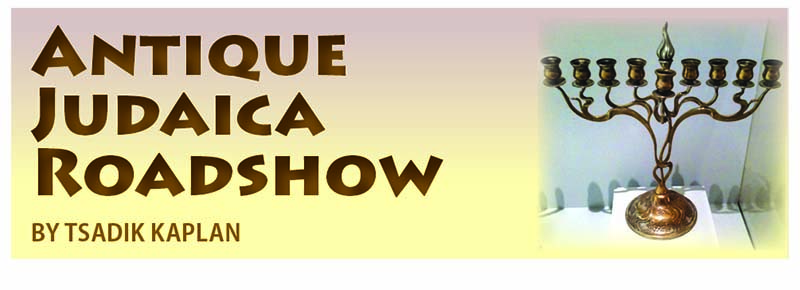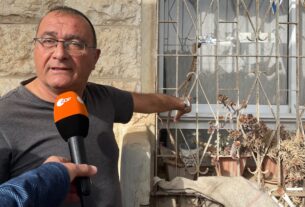This past week in New York, Sotheby’s held their annual fall sale of antique Judaica, which featured ceremonial objects, paintings, books, and manuscripts that were of interest to collectors, dealers, and museums worldwide.
The sale results were a mixed bag, with half of the lots offered going unsold. However, as tends to be the case with elite auction houses such as Sotheby’s, the very best items sold, with those lots prompting fierce bidding from people in attendance, and others on multiple telephone lines and the Internet.
<!–
Publisher #16: JewishPress.com
Zone #113: Comment Banner / (02) / News
Size #15: Banner 468×60 (Comments and Mobile) [468×60]
–> ‘); _avp.push({ tagid: article_top_ad_tagid, alias: ‘/’, type: ‘banner’, zid: ThisAdID, pid: 16, onscroll: 0 });
Without question, the star of the ceremonial objects on offer was “A Rare and Large German Parcel-Gilt Silver Hevra Kadisha Beaker,” hailing from the Jewish community of Darmstadt, Germany in 1710. Estimated at $100,000-$150,000, the beaker sold for $287,000. Any and all objects having to do with a burial society usually sell quite well when they appear in the marketplace, as there is a small but passionate subset of Judaica collectors who focus exclusively on items relating to this area. This magnificent beaker, standing almost eight inches tall, is profusely engraved in Hebrew with the names of the burial society members, listed in order of the years in which they joined the Chevra Kadisha of Darmstadt along with the zodiac symbols that their dates of birth fall under.
The winning bidder for this object was John Coffey, director of the North Carolina Museum of Art. I had the chance to briefly speak with Coffey shortly after he purchased this item. He was ecstatic that his museum would be the caretaker of this exceedingly rare, important piece. Before the sale, he had implored his donors of Judaica acquisitions to be generous in their financial pledges toward his attempt at purchasing the beaker. The North Carolina Museum of Art is one of only two general art museums in the country with a permanent gallery devoted to Jewish ceremonial art, and it has a very significant collection that I urge our readers to go see if they happen to be visiting or passing through North Carolina. Coffey remarked that this beaker has a “presence,” and having seen it in person, I wholeheartedly agree.
The highest-achieving lot of the sale was one of three paintings on offer by the iconic portrait artist Isidor Kaufmann, widely considered to be the greatest Jewish painter of the 19th century. The smallest Kaufmann painting I have ever seen (measuring just 6 inches by 7 and 5/8 inches), it depicts an exquisite rendering of a very young boy with payos (sidelocks) sitting in a chair, dressed in an overcoat and fur shtreimel. The work, titled Sohn der Wunderrabbi von Belz (The Son of the Miracle-Working Rabbi of Belz), sold for $704,000 against an estimate of $550,000-$750,000. The one and only time this painting was offered publicly was at auction in Vienna in 1906. It is featured on the cover of the most comprehensive book ever compiled on the known works of Kaufmann, Rabbiner, Bocher, Talmudschuller, Bilder des Weiner Malers Isidor Kaufmann 1853-1921, published in 1995 by the Jewish Museum of Vienna.
Among the printed material on auction was the first English edition of a complete prayer book in America. Published in New York in 1766, only a handful of copies of this siddur have appeared at auction in the past 30 years, as it is quite scarce. While the leaders of the Sephardic Jewish community in London at that time strictly forbade an English translation of a Hebrew prayer book as a bulwark against assimilation, the translator for this book in the British colony of New York, Isaac Pinto, gives some justification for his efforts in the introduction: “[Hebrew], being imperfectly understood by many; by some, not at all… has induced me to attempt a translation in English, not without hope that it will tend to the improvement of my brethren in their devotion.” Given an estimate of $40,000-$60,000, this book sold for $43,750.
Another attention-grabbing publication was the first Jewish cookbook published in America. Titled Jewish Cookery Book, on Principles of Economy, Adapted for Jewish Housekeepers, the book was written in 1871 by Esther Levy of Philadelphia. In it, she offers practical advice for American-born Jews “without benefit of a traditional ethnic education.” Many recipes are included, all of which are in strict adherence with the laws of kashrut. Levy states that “without violating the precepts of our religion, a table can be spread, which will satisfy the appetites of the most fastidious.” Included is a chapter for food for the sick, featuring medicinal recipes for fainting and diphtheria. There are even detailed household cleaning tips, including how to concoct a good bug poison (!) and how to remove mildew. Given an estimate of $15,000-$20,000, the book sold for $16,250.
As in previous Sotheby’s Judaica auctions of recent years, silver ceremonial objects crafted by the Polish-born artisan Ilya Schor performed strongly. These items, all hand made by Schor in New York during the decade of 1950-60, are charming works of art that are also usable Judaica. Two mezuzah cases, one a standard size of eight inches in length, and the other an unusually large size of over nine inches long and very wide width, feature highly detailed engravings of Jewish men and women from Biblical times to the present.
The standard-sized case displayed three scenes: Ruth in a field; Ruth and Boaz; and Ruth and her mother-in-law, Naomi, facing each other, with Naomi resting her hands on Ruth’s shoulders. Given an estimate of $15,000-$25,000, it sold for $23,750. The larger case featured these three scenes: a dancing chassid; a man with kippah and payos, shovel in hand, digging soil; and a rabbi wearing a tallis, his arms outstretched and his mouth open, praying towards the heavens. Framing these scenes were the 12 zodiac signs. Against an estimate of $25,000-$35,000, this case sold for $40,000.
The object that far surpassed expectations was the last Schor-made lot offered, a kiddush cup. Given an estimate of $10,000-$15,000, it sold for the much higher sum of $32,500. The body of the cup is pierced and engraved with Cubist scenes of Moshe Rabbeinu, Aharon, and Dovid Hamelech. The scenes are surrounded by Hebrew inscriptions, including the first stanza of Kol Mikadesh Shevii. The stem of the cup has a verse from the Book of Esther for havdalah, and on the foot of the cup, the blessing said over wine.
On a personal note: I am loaning some antique Chanukah menorahs from my collection to the Leo Baeck Institute in Manhattan for the duration of the holiday. The mission of LBI is to preserve German-Jewish culture, and the menorahs that I have selected all hail from Germany, dating from the 18th century through the 1930s. My menorahs will be on display December 16th through the 30th. The Leo Baeck Institute is located at 15 West 16th Street in Manhattan. Come on by!
‘);
_avp.push({ tagid: article_top_ad_tagid, alias: ‘/’, type: ‘banner’, zid: ThisAdID, pid: 16, onscroll: 10 });




